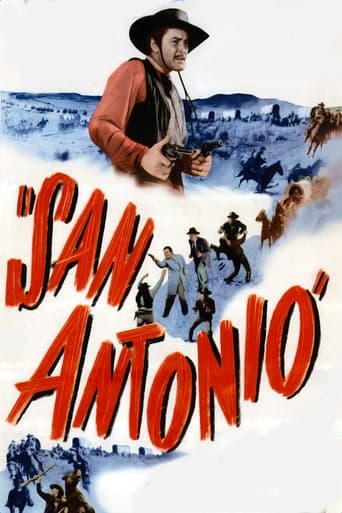

People are voting emotionally.
... View MoreJust what I expected
... View MoreA very feeble attempt at affirmatie action
... View MoreOne of the most extraordinary films you will see this year. Take that as you want.
... View MoreSure, "Dodge City" had only come out six years earlier (i.e., 1939). But, "San Antonio" was definitely _not_ a remake! For one thing, there's no pair of comedy relief sidekicks following Flynn around. Just one, in the form of S.Z. Sakal as Sasha "Bozie" Bozic. And, he's actually Alexis Smith's comedy relief sidekick!Plus, "San Antonio" is a little less grim than "Dodge City." No crusading newspaper men getting shot in the back, or children dying in their mother's arms after being dragged to death by panic-stricken horses. Instead, we merely have one murder; the tragic gunning down of Charlie Bell (played by John Litel) by Roy Stewart's French partner, LaGuerre. Which brings up a third major difference between this epic and "Dodge City." The visible-right-from-the-start tension between LaGuerre and Stewart.Where Dodge City, Kansas, was solely under the control of Bruce Cabot (as Surrett), here we have two men engaged in their own private competition to end their grudgingly equal partnership as controllers of "old San Antone." A plot device I'd previously only seen used in gangster-movies! Last, but not least? Alexis Smith's beautiful singing and acting.Add them all together, and you have nothing less than a perfect ten of a horse opera.
... View MoreAfter a layoff of four years from the American west, Errol Flynn returns to the western genre in a stylish film about post Civil War Texas and a man looking for some justice for himself and his fellow cattle ranchers. Errol's been in exile in Mexico, but he's back now with the evidence against cattle rustling Paul Kelly who is the local boss of the San Antonio area.Flynn makes it to San Antonio and in the process hooks up with entertainer Alexis Smith and her two retainers Florence Bates and S.Z. Sakall, a pair of the biggest scene stealers that the movies ever had. Smith is appearing at Kelly's saloon there, courtesy of his partner Victor Francen for whom she worked back in New Orleans. Francen's an ambitious sort and wants to cash in Kelly's other businesses besides the saloon. So we've got two villains working their own agendas at cross purposes whom Flynn has to deal with.Errol Flynn did a total of eight westerns, but only San Antonio got any kind of recognition from the Academy. San Antonio was nominated for two Oscars, for Art&Set Decoration for a color film and for Best Song with Some Sunday Morning which Alexis Smith sings in a saloon scene. The song is a good one, Dick Haymes had a record of it that sold quite a bit back in the day.All the cast had to keep on their toes with both Florence Bates and S.Z. Sakall in the cast. Especially 'Cuddles' Sakall. Part of the plot involves Sakall witnessing the murder of Flynn's friend and ally John Litel and being intimidated by the bad guys. With his eye rolling and fractured English, Sakall is at his best in San Antonio.For the traditional western fan there's enough gunplay and fights to satisfy anyone. Flynn has a nice triangular shootout with both Kelly and Francen at the Alamo ruins, each man trying to get the other two for their own reasons. I say ruins because the chapel had not been restored yet as a historical monument as it is now in downtown San Antonio. As for the film, San Antonio is a most satisfying western for both fans of the genre and Errol Flynn.
... View MoreUnlike some of the other comments above, I will give this movie great marks for plot, main actors, character actors, story line, suspense, technical proficiency of the director and beauty of the scenery and sets. Admittedly, maybe not Errol Flynn's best, but nothing to be ashamed of either. I saw other comments that Alexis Smith dubbed her singing, don't know how that was known, but my opinion is that this was her own work. You never lose interest from start to finish. The colors in this Technicolor feature are the best I've ever seen of the time period. Great movie. I have it on VHS, would like to get it on DVD but it seems to have disappeared from the marketplace.
... View MoreI saw this film again after many years, and realise more than ever that the chemistry of Flynn/de Havilland is sadly missing,; while Alexis Smith does a reasonable enough job, she seems cold and almost an unwilling participant in this run of the mill Western. The "baddies" were well played by Paul Kelly and Victor Francen, while Cuddles Sakall takes over as Warner's light relief from the old stagers Frank McHugh and Alan Hale who both seemed to be standard casting in Flynn films. The story has been done before, and since, but was enjoyable enough, but I felt the photography was too dark in many scenes (and it was not the print). It was good to see Florence Bates again, and the finale was pretty good, but it is way short of the fun and excitement of "Dodge City"
... View More